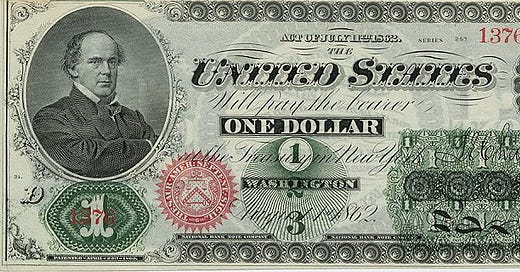1862 — U.S. Government Creates Baseless Money
public domain images from wikimedia commons
Before the American Civil War, monetary transactions had to be backed by gold or silver. Passing a paper note in a business transaction meant that you had access to that amount in the precious metals, similar to how a check you write represents funds you have in deposit in your checking account.
The government only had so much gold and silver, though, and needed a lot more money to wage the war against the Southern States in rebellion, who had already begun to print their own paper money (which became virtually worthless following the South’s defeat, people subsequently using it to line kitchen shelves and even as wallpaper or fire kindling and such).
And so, on this date in 1862, the U.S. government began printing “legal tender,” a term for money as we know it that indicates that the currency (whether it was made from trees or metals) was government-guaranteed to be worth the amount printed on it, even if there was not a literal equivalent of gold or silver to “back it up.”
The decision to do this was very controversial, as many “experts” in banking and finance predicted that this “imaginary money” would lead to the tanking of the economy due to lack of confidence in the scheme on the part of the Country’s citizens, or even that the entire financial infrastructure of the nation would implode as a result.
The paper notes introduced, two of which can be seen above, were called “greenbacks.”
Having more money in circulation actually stimulated the economy — so much so that measures had to be taken to control inflation. Among these measures was the introduction of an income tax as well as other taxes (used primarily to finance the war). Although the Civil War ended eight score of years ago, the income tax is still with us. In other words, we are still paying for the ramifications of the Civil War (in more ways than one) 160 years after its conclusion.
Here are some samples of Confederate money, from wikimedia commons:
Questions: Whose idea was it to print paper money that only had value because people agreed to share the illusion that the notes were worth more than the paper they were printed on? How does this relate or compare to new forms of currency, such as Bitcoin and other forms of Cryptocurrency? Who was William Jennings Bryan, and what was his 1896 “Cross of Gold” speech about? Is bartering a better method of exchanging goods and services than using “legal tender”? What are the advantages and disadvantages of bartering over our more common and modern forms of transactions? How much gold is stored in Fort Knox? What prevents it from being stolen? Is gold ever added to the deposit there, or removed? Would it make any difference if there actually was no gold in Fort Knox, as some people claim?








